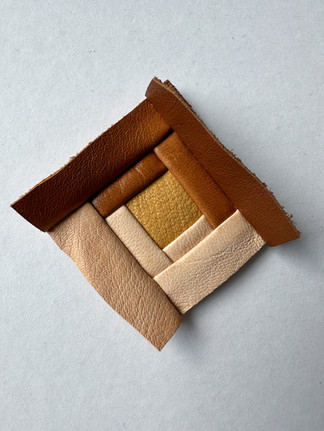Why you should add leather to your modern upcycled quilts; how to source your leather sustainably & choosing the right weight for your projects.
Why quilt with leather? It's actually a really fun material to work with and it adds so much texture to your projects. You can use it in traditional quilt blocks, but it's really suited to modern quilting, especially when you mix it with denim. And yeah, it can be intimidating to work with new materials, so I'm here to help you get started with some tips, tricks, and go-to tools—some of which might surprise you!
But first, let's address the other reason to quilt with denim: textile waste. We know the leather industry has major sustainability issues, and so much ends up in the waste stream. Instead of letting it end up in landfills, we can upcycle it into something beautiful and cherished.
So watch the video or read below to get started.
Where to Find Secondhand Leather for Quilting
If you're ready to incorporate leather into your quilting, sourcing secondhand is the way to go. Here are some great places to find it:
Creative Reuse Centers: I volunteer at a Creative Reuse Center, and it's my top recommendation. Many of these centers collect leftover leather from various industries. The above image will take you to an interactive map that will help you find creative reuse centers across the globe.
Interior Design Surplus: The interior design industry uses a ton of leather, and remnants often go unused. If you’re in an area with a strong design community, you’re more likely to find high-quality secondhand leather.
Your Closet & Thrift Stores: Old leather jackets, bags, and other leather clothing items are great for upcycling. Since they’ve already been broken in, they’re generally easier to work with.
Choosing the Right Weight Leather for Quilting

The most important thing to think about when you are selecting leather for quilting is what weight to use. Unlike traditional fabrics, leather comes in various thicknesses, often measured in ounces—but if you're buying secondhand, those numbers probably won’t mean much. Instead, here’s a more intuitive way to think about it:
Look for leather with movement and drape—lighter weights are easier to quilt with.
If it feels almost like fabric, it's a great choice.
Heavier leather can be useful for straps, details, and appliqué (see below).
For pieced quilt blocks, go with lighter weights since too many seams can create bulk.
Using Leather for Appliqué

One of my favorite ways to use leather in quilting is for raw-edge appliqué. Since you don’t need to turn the edges under, heavier leather scraps work beautifully for this technique. Just stitch the pieces down and you will never need to worry about fraying.
You can draw shapes by hand or use templates to create the shape you want, but my favorite thing to do is to preserve the uneven edges of the leather (if they are still there.
A quick tip: marking on leather can be tricky. Pencils often don’t show up well, so try using a pen or marker instead. Just be sure to test it first to make sure the ink won’t bleed through.
Seam Allowance Considerations
If you're used to quilting with cotton, you're probably familiar with a ¼-inch seam allowance. However, when working with leather, the thickness affects how easily the seams fold:
Lighter leather: A narrow seam allowance (¼ inch) is still doable.
Thicker leather: Increase your seam allowance to about a ½ inch to make folding and managing seams easier.
By adjusting your seam allowances based on leather weight, you'll avoid frustrating bulk and make sewing much smoother.
Next Up:
Check out Part 2 to see all my favorite tools for cutting, stitching, pressing and reinforcing leather.







This is so cool! I've made suede patchwork pillows in the past. Using a leather needle is key, and pounding seams open with a rubber mallet really helps "iron" them down. I did costuming for many years in the El Paso, Texas area back when many boot companies manufactured there. The scrap leather places were SO great, and much of it sold by the pound.